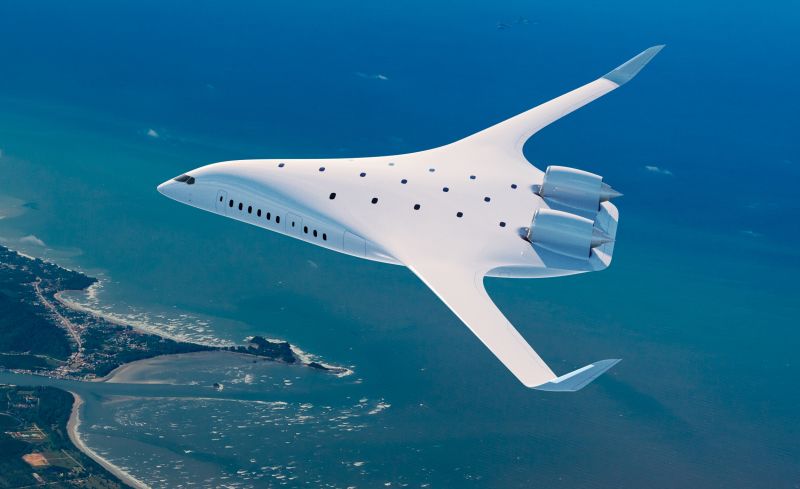The basic design of commercial airplanes hasn’t changed much in the past 60 years. Modern airliners like the Boeing 787 and the Airbus A350 have the same general shape as the Boeing 707 and the Douglas DC-8, which were built in the late 1950s and solidified the “tube and wing” form factor that is still in use today.
This is because commercial aviation prioritizes safety, favoring tried-and-tested solutions, and because other developments — in materials and engines, for example — mean the traditional design is still relevant.
However, as the industry desperately looks for ways to reduce carbon emissions, it faces a somewhat tougher challenge than other sectors precisely because its core technologies have proven so hard to move away from. The time might be ripe to try something new.
One proposal is the “blended wing body.” This entirely new aircraft shape looks similar to the “flying wing” design used by military aircraft such as the iconic B-2 bomber, but the blended wing has more volume in the middle section. Both Boeing and Airbus are tinkering with the idea, and so is a third player, California-based JetZero, which has set an ambitious goal of putting into service a blended wing aircraft as soon as 2030.
“We feel very strongly about a path to zero emissions in big jets, and the blended wing airframe can deliver 50% lower fuel burn and emissions,” says Tom O’Leary, co-founder and CEO of JetZero. “That is a staggering leap forward in comparison to what the industry is used to.”
Under pressure
The blended wing concept is far from new, and the earliest attempts at building airplanes with this design date back to the late 1920s in Germany. American aircraft designer and industrialist Jack Northrop created a jet-powered flying wing design in 1947, which inspired the B-2 in the 1990s.
As a sort of hybrid between a flying wing and a traditional “tube and wing,” the blended wing allows the entire aircraft to generate lift, minimizing drag. NASA says that this shape “helps to increase fuel economy and creates larger payload (cargo or passenger) areas in the center body portion of the aircraft.” The agency has tested it through one of its experimental planes, the X-48.
Over about 120 test flights between 2007 and 2012, two unmanned, remote-controlled X-48s demonstrated the viability of the concept. “An aircraft of this type would have a wingspan slightly greater than a Boeing 747 and could operate from existing airport terminals,” the agency says, adding that the plane would also “weigh less, generate less noise and emissions, and cost less to operate than an equally advanced conventional transport aircraft.”
In 2020, Airbus built a small blended wing demonstrator, about six feet in length, signaling interest in pursuing a full-size aircraft in the future. But if the shape is so effective, why haven’t we yet moved to building planes based on it?
According to O’Leary, there is one main technical challenge holding manufacturers back. “It’s the pressurization of a non-cylindrical fuselage,” he says, pointing to the fact that a tube-shaped plane is better able to handle the constant expansion and contraction cycles that come with each flight.
“If you think about a ‘tube and wing,’ it separates the loads — you have the pressurization load on the tube, and the bending loads on the wings. But a blended wing essentially blends those together. Only now can we do that with composite materials that are both light and strong.”
Such a radically new shape would make the interior of the plane look and feel wildly different to today’s widebody aircraft. “It’s just a much, much wider fuselage,” O’Leary says. “Your typical single-aisle plane has three by three seats, but this is a sort of a shorter, wider tube. You get the same amount of people, but you might have 15 or 20 rows across the cabin, depending upon how each particular airline will configure it.
“This just gives them a whole new palette with which to lay it out. I think it’s going to be amazing to see what their interpretation of this much broader space will be.”
Revolutionary potential
O’Leary says that the nearest equivalent in terms of size would be the Boeing 767 – a widebody, twin-engine plane introduced in the 1980s that typically carried around 210 passengers. It’s still produced as a cargo plane but was replaced by the Boeing 787 as a passenger aircraft. It also has a modern military variant, the KC-46, which the US Air Force uses for aerial refueling.
Similarly, JetZero wants to simultaneously develop three variants: a passenger plane, a cargo plane and a fuel tanker. The blended wing shape lends itself so well to the latter that the US Air Force has just awarded JetZero $235 million to develop a full-scale demonstrator and validate the performance of the blended wing concept. First flight is expected by 2027, which means the military version of the plane is scheduled to lead the way and perhaps support the development of the commercial models.
However, building an entirely new airplane from scratch is an enormous task, and JetZero’s targets sound ambitious, given that the full process of certification for even a variant of an existing aircraft can take years. One advantage JetZero has in this area is that the plane will initially borrow engines from today’s narrowbody aircraft, like the Boeing 737 — although the plan is to eventually move to completely emission-free propulsion powered by hydrogen, which would require new engines that haven’t yet been developed.
JetZero doesn’t have any orders for its plane yet, but O’Leary says airlines are interested. “We’re talking to all the major airlines globally already, because they’re excited to hear about the efficiency gains.”
It remains to be seen whether a 50% reduction in fuel use is actually possible. Both NASA and Airbus quoted a more modest 20% for their designs, while the US Air Force says a blended wing aircraft could “improve aerodynamic efficiency by at least 30% over current Air Force tanker and mobility aircraft.”
“It’s important to note that while a blended wing body can reduce drag and increase fuel efficiency, the actual benefits depend on the specific design, configuration, and operational conditions,” says Bailey Miles, an aviation analyst at consulting firm AviationValues.
“Extensive aerodynamic testing and optimization are essential to fully realize the drag reduction potential of this innovative aircraft design. It would be hard to determine a specific percentage fuel reduction without the necessary tests,” he adds.
According to Miles, the blended wing design is a “revolutionary” idea that has potential, but it comes with a number of hurdles, specifically an increased aerodynamic complexity that can make design and testing tricky, a series of regulatory and certification challenges, and a shape that may not be suitable for existing airport infrastructure.
“The blended wing body aircraft holds immense promise as a game changer in the aviation industry, offering the potential for improved fuel efficiency, enhanced payload capacity, and innovative control systems. However, addressing the aerodynamic complexities, ensuring structural integrity, navigating regulatory hurdles, and adapting airport infrastructure are formidable challenges that must be overcome for it to become a reality,” he says, adding that these challenges, among others, make JetZero’s target of 2030 for entry into service “inconceivable.”
According to Richard Aboulafia, an aviation analyst at consulting firm Aerodynamic Advisory, while not all of JetZero’s claims can be verified, “the idea of a blended wing body has been quite appealing for years, and it sounds like they’ve done some very interesting research. My colleagues and I regard it as quite promising.”
He is concerned that the firm is mostly “a design shop” at the moment, but he believes that the project may take off with the help of contractors. “There’s certainly room for somebody who actually wants to add value in this industry,” he says.







































